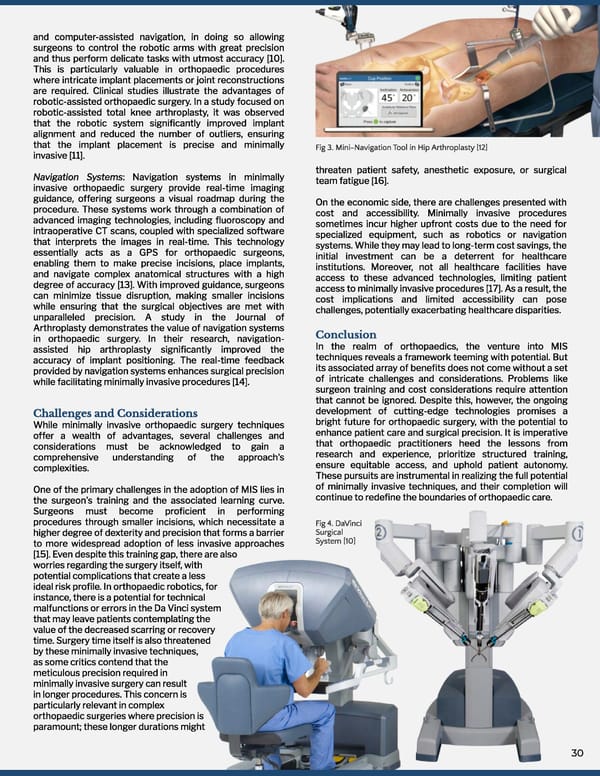and computer-assisted navigation, in doing so allowing surgeons to control the robotic arms with great precision and thus perform delicate tasks with utmost accuracy [10]. This is particularly valuable in orthopaedic procedures where intricate implant placements or joint reconstructions are required. Clinical studies illustrate the advantages of robotic-assisted orthopaedic surgery. In a study focused on robotic-assisted total knee arthroplasty, it was observed that the robotic system signi昀椀cantly improved implant alignment and reduced the number of outliers, ensuring that the implant placement is precise and minimally Fig 3. Mini-Navigation Tool in Hip Arthroplasty [12] invasive [11]㠀 threaten patient safety, anesthetic exposure, or surgical Navigation Systems: Navigation systems in minimally team fatigue [16]㠀 invasive orthopaedic surgery provide real-time imaging guidance, offering surgeons a visual roadmap during the On the economic side, there are challenges presented with procedure. These systems work through a combination of cost and accessibility. Minimally invasive procedures advanced imaging technologies, including 昀氀uoroscopy and sometimes incur higher upfront costs due to the need for intraoperative CT scans, coupled with specialized software specialized equipment, such as robotics or navigation that interprets the images in real-time. This technology systems. While they may lead to long-term cost savings, the essentially acts as a GPS for orthopaedic surgeons, initial investment can be a deterrent for healthcare enabling them to make precise incisions, place implants, institutions. Moreover, not all healthcare facilities have and navigate complex anatomical structures with a high access to these advanced technologies, limiting patient degree of accuracy [13]. With improved guidance, surgeons access to minimally invasive procedures [17]. As a result, the can minimize tissue disruption, making smaller incisions cost implications and limited accessibility can pose while ensuring that the surgical objectives are met with challenges, potentially exacerbating healthcare disparities. unparalleled precision. A study in the Journal of Arthroplasty demonstrates the value of navigation systems Conclusion in orthopaedic surgery. In their research, navigation- In the realm of orthopaedics, the venture into MIS assisted hip arthroplasty signi昀椀cantly improved the techniques reveals a framework teeming with potential. But accuracy of implant positioning. The real-time feedback its associated array of bene昀椀ts does not come without a set provided by navigation systems enhances surgical precision of intricate challenges and considerations. Problems like while facilitating minimally invasive procedures [14]. surgeon training and cost considerations require attention that cannot be ignored. Despite this, however, the ongoing development of cutting-edge technologies promises a Challenges and Considerations bright future for orthopaedic surgery, with the potential to While minimally invasive orthopaedic surgery techniques enhance patient care and surgical precision. It is imperative offer a wealth of advantages, several challenges and that orthopaedic practitioners heed the lessons from considerations must be acknowledged to gain a research and experience, prioritize structured training, comprehensive understanding of the approach's ensure equitable access, and uphold patient autonomy. complexities.ꨀ These pursuits are instrumental in realizing the full potential of minimally invasive techniques, and their completion will One of the primary challenges in the adoption of MIS lies in continue to rede昀椀ne the boundaries of orthopaedic care. the surgeon's training and the associated learning curve. Surgeons must become pro昀椀cient in performing procedures through smaller incisions, which necessitate a Fig 4. DaVinci Surgical higher degree of dexterity and precision that forms a barrier System [10] to more widespread adoption of less invasive approaches [15]. Even despite this training gap, there are also worries regarding the surgery itself, with potential complications that create a less ideal risk pro昀椀le. In orthopaedic robotics, for instance, there is a potential for technical malfunctions or errors in the Da Vinci system that may leave patients contemplating the value of the decreased scarring or recovery time. Surgery time itself is also threatened by these minimally invasive techniques, as some critics contend that the meticulous precision required in minimally invasive surgery can result in longer procedures. This concern is particularly relevant in complex orthopaedic surgeries where precision is paramount; these longer durations might 30
 Penn Healthcare Review Fall 2023 Journal— Sports Medicine Page 34 Page 36
Penn Healthcare Review Fall 2023 Journal— Sports Medicine Page 34 Page 36